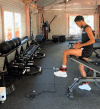Hamstring T-Junction Surgical Repair: An Elite Footballer's Return to Play Journey Through a New Football-Centered Complex Approach
- PMID: 40322525
- PMCID: PMC12048364
- DOI: 10.26603/001c.134126
Hamstring T-Junction Surgical Repair: An Elite Footballer's Return to Play Journey Through a New Football-Centered Complex Approach
Abstract
Background: Hamstring strain injuries have a significant impact in football, with a high re-injury rate, particularly when the distal musculotendinous T-junction (DMTJ) is involved. In some cases, surgical repair is necessary to reduce the risk of re-injury and ensure return to play (RTP) at the pre-injury level.
Study design: Case Report.
Case description: A 24-year-old male football (soccer) player, playing in the Swiss first division, with recidivate hamstring injury, who undercame to surgical repair of DMTJ and returned to play through after 19 weeks. This case report introduces a new football-centered model divided into four main phases, showing how it guided the clinical reasoning used through the RTP process, along with MRI evaluations, clinical outcomes, global positioning system (GPS) data, and strength and power (S&P) neuromuscular testing.
Outcomes: The subject gradually returned to team training after 12 weeks and successfully returned to play after 19 weeks. The player participated in 26 official matches throughout the season, accumulating 1.323 minutes of play without reporting any symptoms at the injury site.
Conclusions: The subject had a successful return to play following the rehab model proposed in this case report, as he was involved in all the matches, and he played without any symptoms or new injuries.
Level of evidence: 5.
Keywords: Football; Return to Play; distal musculotendinous T-Junction; hamstring; surgery.
© The Author(s).
Conflict of interest statement
No potential conflict of interest was reported by the author(s).
Figures










References
-
- Fewer ligament injuries but no preventive effect on muscle injuries and severe injuries: an 11-year follow-up of the UEFA Champions League injury study. Ekstrand J., Hägglund M., Kristenson K., Magnusson H., Waldén M. 2013Br J Sports Med. 47(12):732–737. doi: 10.1136/bjsports-2013-092394. https://doi.org/10.1136/bjsports-2013-092394 - DOI - DOI - PubMed
-
- Epidemiology of muscle injuries in professional football (Soccer) Ekstrand J., Hägglund M., Waldén M. 2011Am J Sports Med. 39(6):1226–1232. doi: 10.1177/0363546510395879. https://doi.org/10.1177/0363546510395879 - DOI - DOI - PubMed
-
- Hamstring injury rates have increased during recent seasons and now constitute 24% of all injuries in men’s professional football: the UEFA elite club injury study from 2001/02 to 2021/22. Ekstrand J., Bengtsson H., Waldén M., Davison M., Khan K. M., Hägglund M. 2023Br J Sports Med. 57(5):292–298. doi: 10.1136/bjsports-2021-105407. https://doi.org/10.1136/bjsports-2021-105407 - DOI - DOI - PMC - PubMed
-
- Economic impact of muscle injury rate and hamstring strain injuries in professional football clubs. Evidence from LaLiga. Nieto Torrejón L., Martínez-Serrano A., Villalón J. M., Alcaraz P. E. Chmura P., editor. 2024PLOS ONE. 19(6):e0301498. doi: 10.1371/journal.pone.0301498. https://doi.org/10.1371/journal.pone.0301498 - DOI - DOI - PMC - PubMed
-
- Injury recurrence is lower at the highest professional football level than at national and amateur levels: does sports medicine and sports physiotherapy deliver? Hägglund M., Waldén M., Ekstrand J. 2016Br J Sports Med. 50(12):751–758. doi: 10.1136/bjsports-2015-095951. https://doi.org/10.1136/bjsports-2015-095951 - DOI - DOI - PubMed
Publication types
LinkOut - more resources
Full Text Sources
Research Materials
